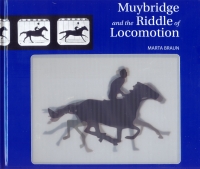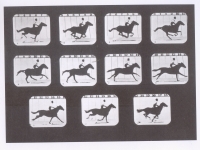| ________________
CM . . . . Volume XX Number 18 . . . . January 10, 2014
excerpt:
Television viewers and movie-goers alike owe a debt of gratitude to Eadweard Muybridge, the inventor of high-speed photography, whose work led to the development of motion pictures. Born Edward James Muggeridge in London in 1830, Muybridge travelled to San Francisco during the 1850s Gold Rush. He learned about cameras and photo development and eventually became famous for his photographs of California landscapes. Leland Stanford, a wealthy landowner, challenged Muybridge to take photos of his prize racehorse, Sallie G, while she was running, in order for him to learn about locomotion. These photographs, taken by multiple cameras in order to capture the horse's movements, were published in newspapers all around the world. Having learned about locomotion through his photos of Sallie G, Muybridge then aimed his camera lens at athletes, animals, people on the street and children at play. He published these photos in a book called Animal Locomotion, and each of the 783 plates had up to 36 images. His book and his invention of the zoopraxiscope, a device used to project motion pictures, led to his being invited to lecture in Britain, Europe and the United States.
Though the subject matter is interesting, this book will have a limited audience. Recommended with reservations. Gail Hamilton is a former teacher-librarian in Winnipeg, MB.
To comment
on this title or this review, send mail to cm@umanitoba.ca.
Copyright © the Manitoba Library Association. Reproduction for personal
use is permitted only if this copyright notice is maintained. Any
other reproduction is prohibited without permission.
NEXT REVIEW |
TABLE OF CONTENTS FOR THIS ISSUE
- January 10, 2014.
AUTHORS |
TITLES |
MEDIA REVIEWS |
PROFILES |
BACK ISSUES |
SEARCH |
CMARCHIVE |
HOME |

 This book focuses on Muybridge's experiments with locomotion photography and the development of the zoopraxiscope, a "projecting magic lantern". Other than a few facts listed in the chronology of his life at the back of the book, readers will not learn much else about this inventor, and though Muybridge's invention was amazing for its time and paved the way for other inventors and photographers, the author's matter-of-fact and rather bland writing style does little to engage readers. Black and white photographs, some of them multiple images of animals or people in motion, and five lenticular images enhance the text. A short list of related books and web sites is also included.
This book focuses on Muybridge's experiments with locomotion photography and the development of the zoopraxiscope, a "projecting magic lantern". Other than a few facts listed in the chronology of his life at the back of the book, readers will not learn much else about this inventor, and though Muybridge's invention was amazing for its time and paved the way for other inventors and photographers, the author's matter-of-fact and rather bland writing style does little to engage readers. Black and white photographs, some of them multiple images of animals or people in motion, and five lenticular images enhance the text. A short list of related books and web sites is also included.